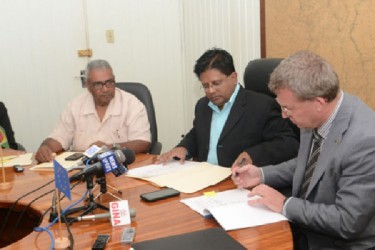Guyana yesterday signed a €23.355M ($6.3B) financing agreement for funding from the European Union (EU) to support the sugar industry and head of the EU Delegation Ambassador Robert Kopecky said one of the crucial requirements to ensure the full payout is the conversion of land for mechanisation.
“I hope that this will trigger the sustainability of the industry,” Ambassador Kopecky said after Minister of Finance Dr Ashni Singh signed the 2012 Financing Agreement for the Guyana Annual Action Programme on Accompanying Measures for Sugar Protocol Countries, which is now in its penultimate year.

Kopecky explained that the annual allotment was “subject to a screening revision and there will be an evaluation…the availability is €23.5 million; the reality can be 80 percent less.”
He told Stabroek News that one of the most crucial industry requirements was that the Guyana Sugar Corporation had to adequately prepare a certain percentage of land for mechanisation conversion. He stated that the EU wanted to provide Guyana with the full sum of the annual agreement, but that the industry had to make changes. “You would not believe how many thorough rounds of thorough negotiations here in Georgetown and in Brussels we have had to proceed treating [the] sugar sector as an industry,” he observed.
Under the agreement, GuySuCo is expected to meet specific conditions in various areas, including investments and performance, which include mechanisation and replanting. The agreement also notes that drainage and factory improvements have to be addressed.
Kopecky also said that given the media attention that GuySuCo and the industry has been facing for the dismal first crop of just under 48,000 tonnes of sugar produced, he had anticipated what questions would be asked during the press conference. He stated pre-emptively that the previous years were different and that the EU and Guyana had to look toward the future of the industry. “It has been different treatment, it has been different rules in the past…what is important is we cannot regret those times, being them successful or not,” he added.
Prior to 2006, Guyana and other African, Caribbean and Pacific (ACP) countries enjoyed a higher sugar prices with preferential access to the European market. However, the end of the Sugar Protocol saw the gradual cut in the guaranteed price for sugar by 36% over a four-year period from 2006 to 2009.
The EU Ambassador further said that for the past three years in particular the focus has been investments aimed at enhancing the sugar industry, which he suggested is primed for a revival due to the global demand and the boom in global prices. He said that it is imperative to the industry that more of the money allocated be spent on the actual production of sugar.
Kopecky noted that in previous years there were many lessons to be learnt when the agreement began. In 2006, the focus was not necessarily on conditions and performance but instead “it was mitigating the consequences of the end of the preferential treatment of the ACP countries in the European Markets.”
He acknowledged that the previous €91.5 million provided since the multiannual programme commenced was spent on education and social cohesion but “we have been consulting each other and saying this is probably not the way to continue for guaranteeing the sustainability of the industry in the future; we must be more targeted to the industry itself; to the sugar, conversion of lands, mechanisations, support to private farmers….”
The EU Ambassador stated that while Europe was providing the financial assistance, the responsibility fell to those in the industry, “jointly we will make it but the responsibility is on the Guyanese side as the EU is basically providing the funds and some guidance.”
Dr Singh stated that the management of GuySuCo had to commit to a lot of work which would see a lasting turnaround to the sugar industry, which President Donald Ramotar recently described as being at a “crisis” level. He said the “Ambassador quite rightly pointed out that the disbursement of these resources will be contingent upon the achievement of certain targets, which will be critical and the Ambassador also alluded to the extensive negotiations…in identifying the key indicators and the key targets.”
Stabroek News asked if the state of the fields would be addressed and if a comprehensive evaluation would be conducted as a way to identify a potential “key indicator” of systemic troubles. In response, Dr Singh stated “to the best of my knowledge there isn’t an indicator that says a report must be produced on the state of the fields.” He noted that he was the “wrong person to ask,” noting that the government has told the state-owned sugar corporation “that they need to identify the key impediments to increase production and they need to identify viable solutions for overcoming those impediments.”
Many industry experts have been calling on GuySuCo to take a real look at the state of the cane fields and to address the rejuvenation needs. However, the pressures to meet quotas, financial constraints and changing weather patterns have continuously seen the fields themselves ignored.
Dr Singh did finally state that he had no doubts that “a comprehensive study of the state of their fields and what needs to be done to convert those fields or to bring them into greater productivity will be a part of the exercises,” while noting that GuySuCo would be providing a Revised Strategic Plan 2013-2017 shortly.




